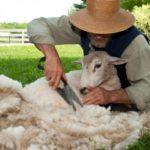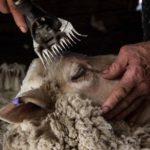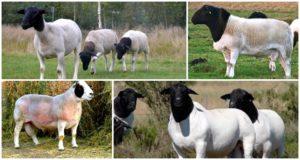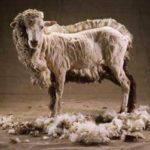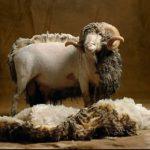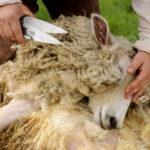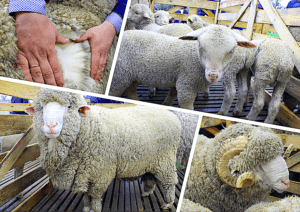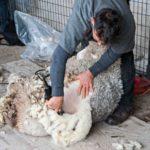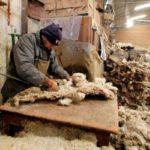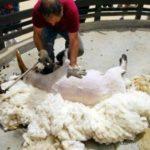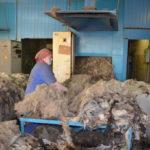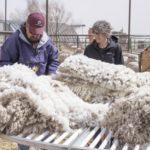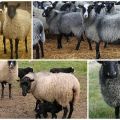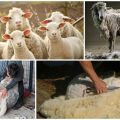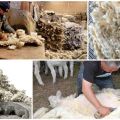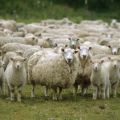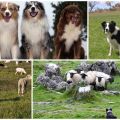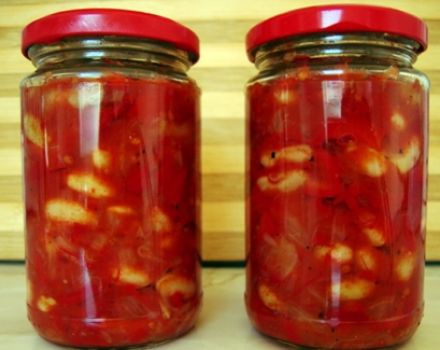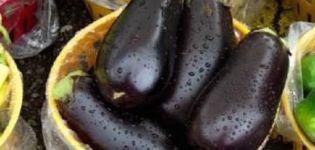What to do at home with sheep wool after shearing and how to do business
Meat and wool are equally important sheep farming products for which animals are bred all over the world. Sheep wool products are in constant demand, especially in cold regions. Sheep breeders must be able not only to feed and care for the herd, but also to receive and process raw wool. Consider what to do with the wool of domestic sheep after shearing, so as not to lose a valuable product, to have a profitable production.
Types of woolen raw materials
The value of sheep's wool is determined by its excellent spinning properties and the ability to turn into felt during processing. Bred sheep breeds with different wool characteristics. The following types of raw materials are in demand:
- Uniform coat. Advantage - the same type of fibers (down, transitional). Fine wool of merino and non-merino breeds is used to make fine woolen threads for clothing, interiors, bed textiles, fine grinding.
- Semi-thin. Obtained from semi-fine fleece sheep and crossbreeds. At the exit of processing - fine-wooled felt used in the shoe and clothing industry, for grinding.
- Semi-coarse. In the composition - awn, fluff, transition fibers. They make felt for mechanical engineering, shoe making.
- Rough. It contains all possible parts of the sheep hair. Taking into account the timing of the haircut, the composition and quality differ. Technical felts are made of coarse wool.
The main characteristics of wool:
- fineness (fine-wooled - from 25 microns and less);
- length;
- tortuosity.
Fine-wool and semi-fine-wool sheep grow well in the Russian climate. Wool is in constant demand, so private farms produce raw materials for sale or bring finished products to the market.
Features of sheep wool processing
Depending on the type of raw material obtained from the sheep, the methods and features of processing are determined.
Fine-wooled direction
The finest fibers have a thickness of 10-14 microns, according to directional standards - no more than 25 microns. Moreover, the length varies between 75-100 millimeters. Raw material consists of one fluff, which is white or close to white. Such raw materials are obtained from sheep of fine-wool breeds:
- rambouye;
- merino Australian, Soviet;
- Kazakh;
- Krasnoyarsk;
- Stavropol.

The highest quality fibers are demonstrated by New Zealand and Australian merino wool, their wool is considered the standard because of its elasticity (up to 20 thousand folds without breaking).Fine-woolen raw materials are used for the manufacture of luxury clothing, products are warm, delicate, light and soft. 4-6 kilograms of the highest quality wool is sheared from one sheep per year.
Semi-fine wool direction
Raw materials of semi-fine wool breeds contain more hair than fluff. Raw material standard is 26-40 microns. Top breeds:
- corridale;
- half-way;
- lincoln;
- romney march.
They are not used for the manufacture of premium clothing; wool is used for the production of felt.
Semi-coarse direction
The raw material contains a lot of transitional hair, in addition to fluff, there is also a non-rigid spine. Sheep belong to meat and wool breeds, give a lot of fat. Representatives:
- Altai;
- Tajik;
- Armenian.
Wool is used in the production of blankets, carpets, felt. The highest quality types of these raw materials are used in the manufacture of fabrics (cheviot, boston). Farmers should be aware that this direction of sheep breeding prevails in Russia, and sales problems are possible.
Coarse direction
Karakul, smushkovaya, Romanovskaya sheep are representatives of the coarse-wooled trend. All wool is used without rejection, the composition of the raw material combines fluff and coarse hair of different colors. Sheep are bred for meat and milk, wool is not the main purpose of the breeds. Fibers reach 60 microns in diameter, coarse and tough.
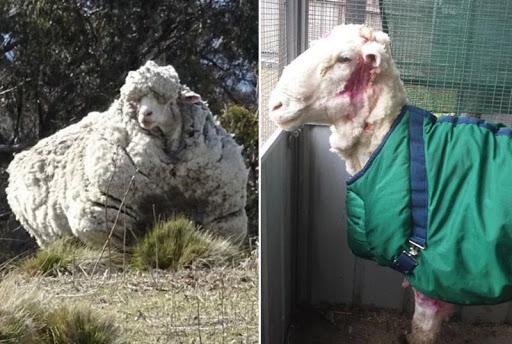
They produce felt, which is in demand in industry and in the manufacture of footwear. Rough material has high strength, does not roll.
Processing tools
Sheep owners should provide on the farm equipment for receiving and processing wool, as well as a dry warehouse for storage. For large flocks, mechanized shearing and processing methods are useful.
The simplest set of tools:
- clipper or scissors for a haircut;
- combs made of wood;
- device for cheski wool (carder);
- spindle, spinning wheel for making yarn;
- loom.
Processing raw materials requires special skills; in many small farms, it is still done by hand.
Shearing
The time of cutting is chosen depending on the breed and the readiness of the coat. Fundamental rules:
- fine-wool and semi-fine-wool - spring, once a year;
- coarse-haired and semi-coarse-haired - spring, autumn (twice).
Fine-wool breeds do not shed, so there is no loss of hair. The time for clipping is chosen when the wool after winter becomes softer and accumulates grease.
For beginners at home, it is important to master the shearing technique and rules for handling a sheep, so as not to spoil the wool and not harm the animal. Sequence:
- the sheep is laid on its side, the legs are tied;
- cut from the abdomen and groin to the chest, protect the nipples with hands;
- stray sections of wool are cut with scissors and removed so that they do not interfere with the manufacture of yarn;
- turn the sheep over, shear the other side;
- plant a sheep, hold its head, remove wool from its back;
- the neck is cut from the head to the body.

The animal is freed from the fetters, the trimmed material is sorted before the initial processing and stored on a tarp or a cleaned barn floor.
Further processing
After the haircut, perform:
- combing and cleaning from dirt;
- drying and frying until the characteristic odor is removed;
- wash, degrease, dry;
- comb and beat for softness and shine.
Then, threads (spun) or felt are made from a pure fleece.
Manufacturing process automation
Manual processing is only possible with small amounts of wool. To mechanize the process, special equipment is used, which increases the cost of production, but helps to process a significant amount of raw materials and, as a result, makes the farm profitable.

For automation used:
- line for washing and cleaning fleece from fat and impurities;
- apparatus for extracting tangles;
- washing and drying machine;
- spinning machines;
- packers.
All machines can be connected by means of a conveyor and an automated yarn-making process can be achieved. The initial costs are paid off by the speed and quality of the final product.
How to choose the right breed
When choosing a breed for obtaining woolen raw materials, the shearing from an individual is taken into account, the quality of the resulting fleece. The fiber of fine-fleeced and semi-fine fleeces of sheep is traditionally in high demand on the market. How much can you get per year from an animal:
| Breed | Annual cut in kilograms |
| Lincoln | 6-10 |
| Soviet merino Australian Altaic askanian | 8-12 5-10 10-12 7-16 |
| Mazaevskaya | 6-12 |
| New Caucasian | 6-9 |
| Kuibyshevskaya | 5-6 |
| Karakul | 3.5-5 |
| Romney March | 8-9 |
Fleece of long-haired breeds is in demand on the market, the fibers have shine, high resistance to wear. The Russian Longhaired and Lincoln are prized for their soft and curly hair. Lincoln sheep love coolness, grow well only under certain conditions. The yield of the purified fleece is 55-60% of the shear weight.
Russian long-haired are less capricious in leaving. They are distinguished by good health, unpretentious, give 3.5-6.5 kilograms of high-quality wool raw materials.
You can get a high-quality fleece from sheep of the Romney Marsh, Kuibyshev, Tien Shan breeds. Sheep of hybrid species are distinguished by endurance, high-quality fine wool, and undemanding food. Tien Shan sheep can feed on pasture in warm regions all year round.
How to start a sheep wool processing business?
A business for the production and processing of wool sheep raw materials can be organized in several ways:
- Organization of our own sheep farm and processing workshop.
- Harvesting (reception from the population) of raw materials, primary processing, delivery to Russian factories or for export.
- Mini-plant for raw material procurement and processing for local sale.
- A full-cycle plant with spinning capacity - in an area with a large number of sheep farms and the possibility of mass purchase of raw materials.
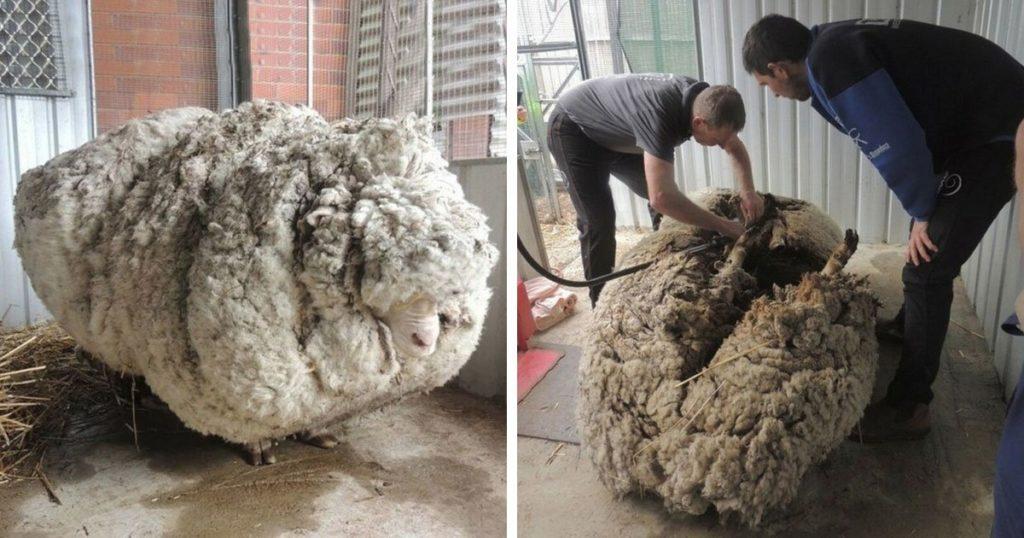
The demand of domestic factories for wool is great, raw materials of any quality are bought for different needs. A mini-factory (processing workshop) requires a small area, the number of workers is 5-30 people.
Advice: processing production can be supplemented with lines for felting, felt production, and a spinning workshop.
Production of things
The far-sighted owners supplement small plants for processing raw materials with workshops for the production of finished products. Handicraft adds exclusivity to products, craftswomen create real masterpieces from felt, felt, knit unique products from spun yarn. The following types of products are in demand:
- for medical purposes - belts, insulation for joints, socks;
- kits for handmade;
- blankets, blankets;
- felt winter shoes, outerwear;
- bath accessories;
- felt for making hats and other products;
- soft slippers.
Designer products are complemented with embroidery and beaded. The fashion for natural materials is constantly growing. The obviousness of handwork, some simplicity of design and shape do not spoil such items, but increase the cost.
Modern market trends
All types of sheep wool are in demand on the market, while sheep breeding in Russia is poorly developed. There are usually no problems with the sale of goods from sheep farms. The sale of finished products is always more profitable than the sale of raw materials, so wool processing production will be useful.
Own raw materials will increase the profitability of the mini-plant. Before starting a business, it is important to make sure that the final product is in demand, in demand in the market, and its price will pay off the costs.The capacity of the plant must correspond to the quantity of raw materials (external procurement).
Starting a wool processing business, you need to find suppliers of raw materials and buyers of finished products. Such factories quickly pay off in sheep-breeding areas where farmers donate wool. Own sheep farm will give the production constant raw materials and the possibility of additional income from meat.
